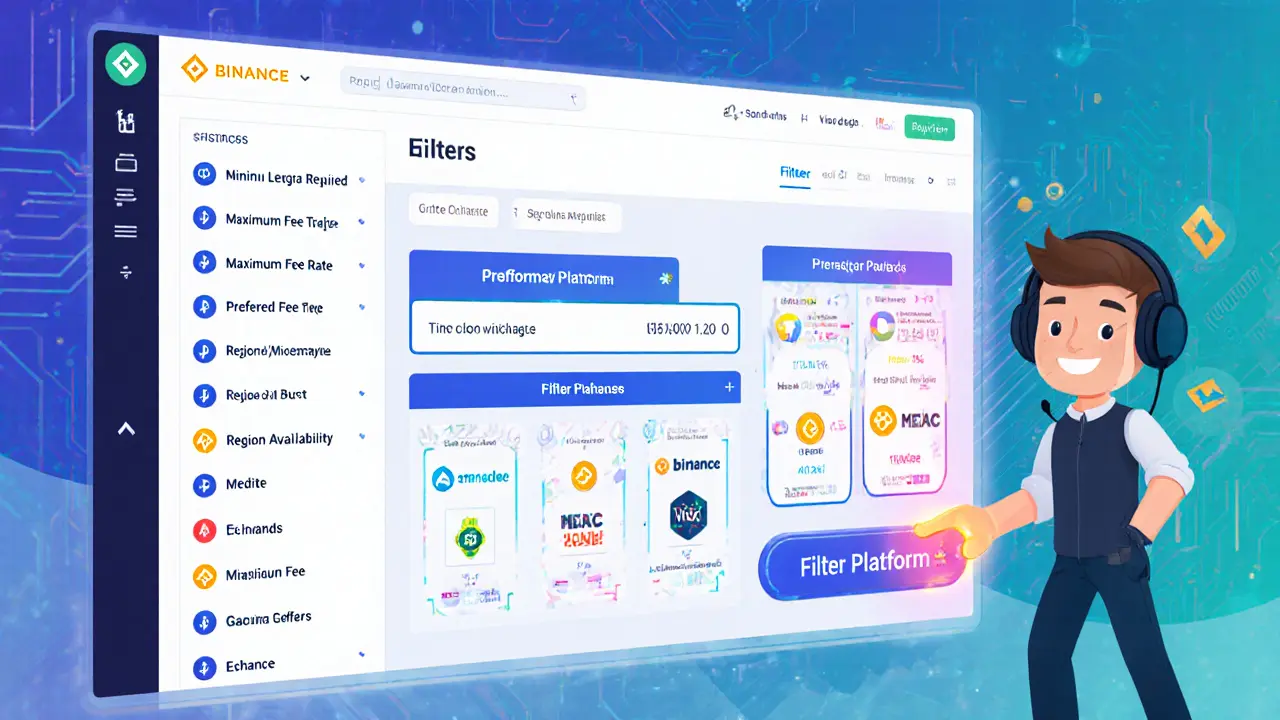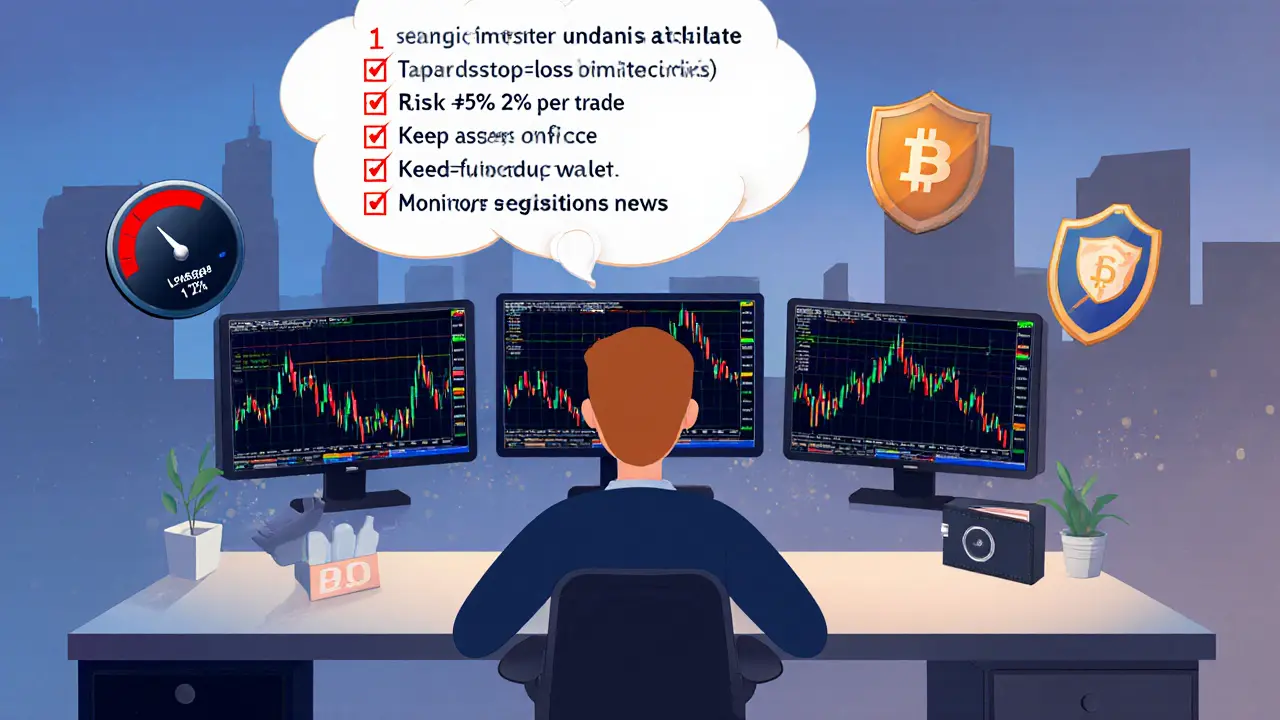Top Crypto Margin Trading Platforms in 2025

Crypto Margin Trading Platform Selector
Use this tool to filter and compare crypto margin trading platforms based on your requirements.
Quick Takeaways
- Bybit, MEXC and OKX lead the market with up to 200× leverage and robust security.
- Binance offers the widest asset selection but limits US access.
- Coinbase is the most beginner‑friendly but caps leverage at 2.5×.
- dYdX provides a non‑custodial, decentralized experience with up to 20× leverage.
- Match your skill level, regulatory needs, and fee tolerance before committing capital.
Crypto margin trading platforms are online services that let traders borrow funds to amplify positions on digital assets. Leverage can range from modest 2× up to an extreme 200×, letting small accounts control large notional values. While the upside looks tempting, the downside-liquidations, fees, and regulatory risk-requires careful platform selection.
How Margin Trading Works
Margin trading splits your account into two parts: the collateral you deposit and the borrowed amount the exchange provides. When you open a leveraged position, the platform locks a portion of your collateral as maintenance margin. If the market moves against you and your equity falls below the maintenance level, the exchange automatically liquidates the position to protect its loan.
Two margin modes dominate the scene:
- Cross margin: all usable collateral in your account backs any open position, reducing the chance of isolated liquidation but spreading risk.
- Isolated margin: only the margin you allocate to a single trade is at risk, giving tighter control but higher liquidation probability.
Understanding funding rates, liquidation prices, and the impact of maker/taker fees is crucial before you pull the trigger.
Key Evaluation Criteria
When you compare platforms, focus on these five pillars:
- Leverage range - Does the platform support the leverage you need for your strategy?
- Fee structure - Maker vs. taker fees, withdrawal costs, and hidden funding rates.
- Security model - Cold storage, multi‑signature wallets, or decentralized custody.
- Regulatory posture - Availability in your country and compliance with local laws.
- Product diversity - Futures, perpetual swaps, options, and leveraged tokens.

Platform Overviews
Binance is the world’s largest crypto exchange, offering up to 125× leverage on futures contracts and more than 600 tradable assets. Its maker fee sits at 0.02% and taker at 0.04% for futures. The platform shines in liquidity and product depth, but US users can’t access margin features due to regulatory constraints.
MEXC is a fast‑growing exchange that pushes leverage up to 200× across 1,400+ futures markets. Spot maker fees are a rare 0.0000%, while futures fees are 0.010%/0.040% (maker/taker). Its asset list exceeds 2,700 spot pairs, making it a favorite for high‑frequency traders. Customer service response times can lag during peak volumes.
Bybit is an intuitive platform offering 200× leverage, a tiered VIP program, and a robust education hub. Fees are transparent across spot, perpetual, and USDC options markets. Bybit’s UI ranks high among beginners, though it’s unavailable to US residents.
OKX is a derivatives‑centric exchange supporting up to 100× leverage, cross‑margin and isolated‑margin modes, and over 350 crypto assets. It provides comprehensive market data, multi‑signature wallets, and regular security audits. OKX services more than 100 countries but still excludes certain jurisdictions.
KuCoin is a user‑friendly exchange that caps futures leverage at 100× and hosts a wide range of altcoins. While its fee schedule is competitive, liquidity on low‑volume pairs can be thin, leading to wider spreads.
Bitget is a platform focused on futures and perpetual swaps with up to 100× leverage and strong charting tools. Its interface is clean, and it offers a variety of order types, but it lacks the depth of Binance’s order book for niche assets.
Coinbase is a regulated exchange under Gibraltar licensing that limits margin to 2.5× but excels in user experience. It also offers tokenized shares and a solid mobile app, making it ideal for newcomers who value safety over extreme leverage.
dYdX is a decentralized, non‑custodial platform delivering up to 20× leverage on perpetual contracts. Maker fees sit at 0.02% and taker at 0.05%. Because it runs on smart contracts, users keep full control of their assets, though fiat on‑ramps are missing and liquidity can dip for less‑traded pairs.
Side‑by‑Side Comparison
| Platform | Max Leverage | Maker Fee | Taker Fee | Assets Offered | Notable Features | US Availability |
|---|---|---|---|---|---|---|
| Binance | 125× | 0.02% | 0.04% | 600+ | Deep liquidity, futures & options | No (margin) |
| MEXC | 200× | 0.0000% (spot) | 0.025‑0.040% (spot) / 0.040% (futures) | 2,700+ | Largest spot market count, low fees | Yes |
| Bybit | 200× | 0.02% (maker) | 0.06% (taker) | 200+ | VIP tiers, USDC options, education hub | No |
| OKX | 100× | 0.02% | 0.05% | 350+ | Cross/isolated margin, options, regular audits | Partial |
| KuCoin | 100× | 0.025% | 0.065% | 300+ | Simple UI, wide altcoin range | Yes |
| Bitget | 100× | 0.02% | 0.06% | 150+ | Advanced charting, futures focus | Yes |
| Coinbase | 2.5× | 0.00% (maker) | 0.50% (taker) | 120+ | Regulated, tokenized shares, UI polish | Yes (full) |
| dYdX | 20× | 0.02% | 0.05% | 133+ | Non‑custodial, 99.9% uptime | Yes (no fiat) |
Choosing the Right Platform for Your Strategy
Match your profile against the table above:
- High‑frequency scalpers - MEXC or Bybit deliver the deepest order books and 200× leverage.
- Risk‑averse beginners - Coinbase’s 2.5× limit and regulated environment reduce surprise liquidations.
- DeFi enthusiasts - dYdX lets you keep custody of your keys while still trading leveraged contracts.
- Global traders needing cross‑margin flexibility - OKX’s dual‑margin modes and extensive derivatives suite excel.
Don’t chase the highest leverage alone. Higher leverage magnifies fees, funding rates, and liquidation risk. Start low, test the platform’s order execution, then scale up once you’re comfortable.
Risk Management & Best Practices
Even the best‑executed trade can go sideways. Embed these habits into every session:
- Set a hard stop‑loss at 1‑2% of your total account balance.
- Never risk more than 5% on a single position, regardless of leverage.
- Monitor funding rates daily; negative rates can drain profits on perpetual contracts.
- Keep a portion of assets in cold storage or a hardware wallet to safeguard against exchange failures.
- Stay updated on regulatory news-platforms can abruptly suspend services for certain regions.
Most exchanges now offer demo or test‑net environments. Use them to rehearse order types and margin calls before you allocate real capital.

Frequently Asked Questions
What is the difference between cross margin and isolated margin?
Cross margin pools all available collateral to cover any open position, reducing the chance of liquidation on a single trade. Isolated margin locks only the margin you assign to a specific position, giving tighter control but a higher liquidation risk if that trade moves against you.
Can I use a US‑based bank to fund margin accounts on these platforms?
Most platforms that restrict US residents (Binance, Bybit, MEXC) do not accept US bank transfers. Coinbase and Kraken do, but they limit leverage. Always check the platform’s deposit methods for your country before signing up.
How do funding rates affect perpetual contracts?
Funding rates are periodic payments exchanged between long and short traders to keep a perpetual contract’s price tethered to the spot market. A positive rate means longs pay shorts; a negative rate flips the flow. Large or rapidly changing rates can erode profits or increase costs, so monitor them before holding a position overnight.
Is dYdX really non‑custodial?
Yes. When you trade on dYdX, your funds stay in your own wallet and are only locked in smart contracts during a trade. The platform never holds private keys, which reduces the risk of exchange hacks but adds the responsibility of managing your own security.
Which platform offers the lowest overall trading fees?
MEXC leads with a 0.0000% maker fee on spot trades and competitive 0.010% maker on futures. For perpetual contracts, Bybit and OKX are close, but fee structures vary by volume tier, so calculate your expected monthly turnover to see the true cost.

20 Comments
The whole margin hype is just a front for a deeper power grab by the big exchanges. They lure newbies with 200× promises while they quietly line their pockets with hidden funding fees. Every time the market twists, you see another forced liquidation cascade that benefits the liquidity providers. It’s not a coincidence that the platforms with the highest leverage also have the most opaque corporate structures. Keep your eyes open and you’ll see the pattern repeating across jurisdictions.
Indeed, the leverage offerings are enticing, however, users should meticulously review the fee schedules, the margin calls, and the platform's regulatory standing, especially before committing significant capital.
Seeing the breakdown of each platform really helps in picking a spot that matches one’s risk appetite. If you’re after deep liquidity, Binance still leads the pack, but the US restrictions can be a deal‑breaker. For those who value a simple UI and regulatory safety, Coinbase’s low leverage feels comforting. Meanwhile, the decentralized vibe of dYdX is a fresh breath for people who don’t trust custodial wallets. Ultimately, testing a demo account before going live is a solid habit.
From a risk‑management perspective, the correlation between high leverage and slippage cannot be ignored. Execution latency on platforms with thin order books can amplify losses beyond the calculated liquidation price. Moreover, the funding rate volatility on perpetual swaps adds an extra hidden cost that many traders overlook. A robust back‑testing framework should incorporate these variables, not just the headline fee percentages.
Leverage is a double‑edged sword.
i think most ppl just chasin tha hype nd dont even check the fine print its all about the short term gains i guess but yeah whatever
For anyone building a strategy, I’d suggest starting with a modest 5× or 10× and focusing on consistent position sizing. That way you can gauge the platform’s order execution quality before scaling up.
The article’s list is solid, but it glosses over the importance of insurance funds on futures exchanges. Without an adequate fund, sudden market moves can trigger cascading liquidations that hurt retail traders.
In the grand tapestry of digital asset derivatives, one must discern the subtle nuances that separate a mere exchange from a bastion of financial engineering. While most platforms parade their leverage as a badge of honor, the true merit lies in the robustness of their risk‑mitigation protocols, the transparency of their fee structures, and the sanctity of user custodial holdings. A discerning trader extracts value not from the headline 200×, but from the quiet confidence that the platform will not vanish under duress.
Simple rule of thumb: if the platform’s fee tier looks confusing, walk away.
Everyone jumps on the 200× hype, but the real edge is in low‑fee spot arbitrage, which most of these so‑called “high‑leverage” sites overlook.
Upon a meticulous examination of the presented data, one discerns a conspicuous omission: the systemic risk inherent to leveraged positions is not merely a function of fee percentages but is deeply intertwined with the macro‑economic volatility that pervades the digital asset sphere. Firstly, the leverage multiplier, while ostensibly advantageous, intrinsically amplifies exposure to price oscillations beyond the trader’s immediate control. Secondly, the funding rate mechanisms, often relegated to footnotes, possess the capacity to erode capital at an insidious pace, especially during periods of market stress. Thirdly, the often‑overlooked liquidity depth on less‑traded pairs can precipitate slippage that outstrips any nominal fee advantage. Fourthly, regulatory ambivalence across jurisdictions introduces an element of legal uncertainty, where abrupt policy shifts can culminate in forced liquidation or platform shutdowns. Fifthly, the security architecture-ranging from cold storage ratios to multi‑signature protocols-varies dramatically among the enumerated exchanges, thereby influencing the probability of custodial compromise. Sixthly, the presence or absence of an insurance fund serves as a bulwark against systemic failures, yet its adequacy is seldom disclosed in transparent terms. Seventhly, the user experience, while subjective, impacts order execution speed; latency differentials of even a few milliseconds can be decisive in high‑frequency environments. Eighthly, the interoperability of the platform with decentralized finance (DeFi) primitives may either augment or dilute the risk profile, contingent upon the smart contract audit rigor. Ninthly, the tax reporting obligations, which differ markedly between regions, can impose hidden costs that erode net profitability. Tenthly, the psychological dimension-namely, the trader’s propensity for over‑leverage in the face of alluring high‑margin advertising-cannot be discounted. In sum, a holistic appraisal demands an integration of these multifarious factors, transcending the simplistic allure of headline leverage figures.
Oh sure, just grab 200× and watch your account vaporize-because everything on the internet is a guaranteed win, right?
Keep your risk low, stay consistent, and you’ll see steady growth over time.
Looks like another generic overview, nothing new.
Same old list, pretty boring.
If you’re new to margin trading, start on a platform that offers robust educational resources and a clear fee breakdown. Many beginners find Coinbase’s UI helpful, though the low leverage may feel limiting at first.
Ah, the classic ‘pick your poison’ narrative-because every trader is a mastermind plotting to outwit the market, all while the shadowy cabal of exchange CEOs silently cheer on your inevitable downfall. You see, the real drama unfolds behind the glossy UI, where hidden funding rates and insurance fund deficits conspire to eat your profits. And let’s not forget the ever‑looming regulatory specter, ready to swoop down and freeze assets for no apparent reason. So go ahead, choose your platform, but remember: the house always wins, and the house is wearing a mask.
In the grandiloquent pursuit of leverage, one must contemplate the ontological ramifications of entrusting one’s capital to algorithmic behemoths; alas, the market’s entropy remains indifferent to our philosophical musings. 🤔
America’s best traders know the best platforms are the ones that don’t bow to foreign regulations so we can keep our profits pure and unfiltered from any overseas meddling